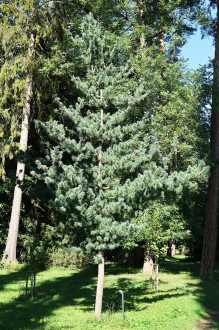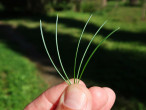(Pinus parviflora Sieb. et Zucc.)
Habitus
- tree 10 – 20 (30) m tall, conical crown – densely and deeply branched
- the branches are in whorls and stand almost vertically from the trunk
- bark dark gray, rectangularly split, the edges stand out from the trunk
Leaves (assimilation organs)
- needle-like assimilation organs 5 – 7 x 1 mm in size
- they grow in groups of 5 on brachyblasts !, they are densely grouped in a brush-like manner at the end of the branches
- triangular in cross-section, with distinct silvery bands of vents on the inner sides
- last for 3-4 years
Flowers
- monoecious woody plant, flowers of different sexes - cone-shaped
- male (♂) cones are egg-shaped, yellow (or purple)
- female (♀) cones are cylindrical, pinkish green on 4-6 mm long stalks, grow 2-4 in whorls at the end of this year's shoot
Fruits – seeds
- the fruit is a cone 40-90 x 30-40 mm large, ovoid, grayish brown, resinous
- seed scales are sparsely grouped !, relatively thick, woody
- the label is diamond-shaped, the umbilicus is not very clear - slightly bent inwards
- the pine cone opens wide after ripening and remains on the tree for 5-7 years
Extension
- originally it is widespread on the Kuril Islands, in Japan on the islands of Shikoku, Honshu and Hokkaido at altitudes from 1,300 to 2,500 m above sea level.
- it was introduced to Europe in 1846
Ecology
- is semi-shade-loving, undemanding to the content of nutrients in the soil
- relatively frost-resistant in Slovak conditions
- grows slowly
Significance
- decorative woody plant with habit, needles and fruits
- creates multiple growth forms











